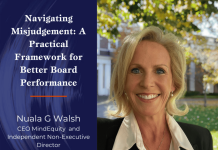The podcast and the article are brought to you by The Better Boards Podcast Series.
With the fast-paced democratisation of AI and advanced analytics, problem-solving will be commoditized (even for complex challenges). As C-suite and board members gain awareness of the possibilities and power of AI and analytics, an almost unlimited array of potential projects, questions, or scenarios where analytics could improve outcomes arises. The challenge is how to prioritize the various opportunities, ensuring they align with company goals.
In this podcast, Dr Sabine Dembkowski, Founder and Managing Partner of Better Boards, engages in a discussion about the use of AI and advanced analytics to deliver substantial value in the boardroom with Professor Bernardo Almada-Lobo, co-author of The Analytics Sandwich: Bringing People and Artificial Intelligence Together to Unlock Business Value. Professor Almada-Lobo, a distinguished faculty member of engineering and business at the University of Porto, and co-founder and partner of LTPlabs, an advanced analytics and AI consultancy, brings his extensive experience to the table. His background as a former researcher at the MIT Sloan School of Management and a former Board member of INES TEC, coupled with his certification as a Certified Analytics Professional (CAP) and a Ph.D. in Industrial Engineering and Management, ensures that the insights shared are of the highest quality.
“If you really want advanced analytics and AI to deliver game-changing value, the secret sauce is to approach it with short, laser-focused projects”
Bernardo explains that organizations often take two ineffective approaches to AI and analytics, leading to predictable and disappointing outcomes. They either embark on a massive analytics project, or different teams initiate numerous mini projects driven by personal curiosity or bias. He underscores the need for a strategic, business-led approach, focusing on short, laser-focused, collectively agreed upon projects that are directly tied to strategy. This approach, when integrated into strategic planning and aligned with company goals, ensures faster, more relevant, actionable outcomes and prevents project failures, providing a roadmap for success.
“Using AI and advanced analytics tools is no different from any other tools that we employ in business”
Bernardo has found a quirk in working with global companies: CEOs and C-suite leaders are eager to use AI for operational efficiencies or redesigning supply chains but hesitant to use it for decision-making. He believes this reluctance may stem from a fear of losing the perceived omniscience that leaders often feel is expected of them. However, advanced analytics rarely identifies a single “best” solution; it expands the solution space, offering multiple options. Business experts can then evaluate these options against strategic goals and constraints. Like any business tool, AI tools are meant to assist, not replace, leaders, helping them make more informed decisions.
“This technology has the potential to affect every industry and every function of a company”
Bernardo believes that one of the greatest advantages of this technology is its potential ability to impact every industry and company, from strategy and finance to sales, marketing, and operations. Thus, boards must understand the opportunities and disruptions AI, generative AI, and advanced analytics present. This awareness helps avoid two common pitfalls. The first pitfall is that boards may demand AI projects in a push analytics approach without organizational alignment, focusing on available data rather than the problems or opportunities needing solutions. Second, management teams may move faster on opportunities than their boards are prepared for. Therefore, Bernardo advises: make sure advanced analytics is decision-driven to guarantee the right questions are answered. Organizing ideas into a value tree helps break down main objectives into business value drivers and related KPIs, which AI and advanced analytics can address. The key is to anchor analytics on decision to be made rather than available data, shifting from push-to-pull analytics.
Despite the transformative potential of AI, only a small minority of organizations are reaping its profound benefits. Bernardo believes that the gap between AI’s promise and its actual business impact is mainly due to people and process issues rather than technology. To make a tangible impact, the process must be problem-centric. This means identifying key business challenges and opportunities that align with the strategic vision. Only then should analytics and data framing be brought in. This pull analytics approach is more effective than the traditional push analytics.
“By integrating AI and advanced analytics, boards can enhance their effectiveness, make more informed decisions, and drive organisational success”
Bernardo explains that looking at the responsibilities of any board (strategic planning, risk oversight, and stakeholder concerns), integrating AI and advanced analytics can significantly enhance their effectiveness, inform decision-making, and drive organizational success. He lists several strategies boards can use, categorized by their focus on effectiveness, efficiency, or people-related concerns.
1. Effectiveness-Oriented Strategies:
- Data-Driven Decision Making: using AI to analyze large data sets and generate insights for informed decisions. This includes evaluating market trends, financial performance, and risk assessments using data from internal sources, global news, political developments, social media, industry reports, and competitive strategies.
- Risk Management: Implementing AI to monitor and predict potential risks by identifying and quantifying external drivers of uncertainty. Analyzing patterns and anomalies helps boards mitigate risks effectively.
- Strategic Planning: Utilising predictive analytics and AI to create future scenarios and strategies, aiding in long-term planning. This includes questioning critical assumptions about customers, technologies, and competitors, free from human biases.
2. Efficiency-Oriented Strategies:
- Performance Monitoring: Leveraging AI to track and evaluate organizational performance in real-time, benchmarking against best practices, identifying KPIs, and highlighting areas needing attention.
- Efficient Reporting: – Automating data collection and analysis for board reports, reducing time and effort while ensuring accuracy.
3. People-Related Strategies:
- Improved Governance: Using AI tools to enhance governance practices by automating compliance checks, monitoring regulatory changes, and ensuring adherence to corporate policies.
By incorporating these strategies, boards can promote data-driven decision-making, proactive risk management, and effective strategic planning, all while improving efficiency and governance.
“Any director who fails to integrate AI into their work and decision-making process in the near future will not be allowed to serve on the board”
Bernardo warns that to apply AI effectively, boards need to assess their composition, ensuring members are diverse and qualified to address current gaps. Board members should possess basic AI literacy, which will become a standard requirement. They should ask themselves if they can leverage AI to provide strategic support. Beyond strategic planning and talent management, AI can also benefit from risk management, performance monitoring, efficient reporting, and stakeholder engagement. Integrating AI into these areas can further enhance board effectiveness and organizational success.
“Analytics is not a substitute for people. It’s a support, a way that we have to harness their knowledge and combine that knowledge with state-of-the-art AI and machine capability to augment, instead of replacing”
Bernardo gives a list of tips for the C-Suite on AI Integration.
- Walk the Talk. Evaluate capabilities and ensure your organization has the necessary talent, culture, and capabilities to embrace the changes AI requires. Lead by example, with the board actively engaging in and supporting AI initiatives, fostering a culture that values data-driven decision-making over intuition. Also, invest in talent, recruiting and developing talent skilled in AI and ensuring ongoing training to keep pace with technological advancements.
- Align AI and Advanced Analytics with Business Objectives and Culture. Have a strategic vision and prioritize identifying key business challenges and opportunities where AI and analytics can make a tangible impact. Avoid engaging in interesting but not impactful projects. Develop a problem-centric approach, focusing on solving real business problems and addressing specific business needs rather than implementing AI for the sake of technology. Also, AI initiatives should be aligned with the organizational culture to facilitate smooth adoption and integration. This includes fostering a mindset that values data-driven insights and experimentation.
- Combine People and Analytics. Leverage human expertise. Recognize that people in your organization have valuable insights and contextual knowledge crucial for effective decision-making. Use AI to augment, not replace, this expertise. Foster collaboration and relationships where people learn from AI, AI learns from people, and the organization learns and adapts. Enhance decision-making using AI to provide data-driven insights, freeing employees to focus on strategic and creative tasks.
“I don’t believe that AI will replace corporate boards, neither now nor in the distant future”
Bernardo points out that one advantage of AI, generative AI, and advanced analytics is their potential to transfer successful use cases across companies and industries. Non-executive board members, who often bring diverse experiences from various sectors, can leverage these technologies to challenge management with pertinent questions. He explains that generative AI can help non-executive board members prepare for meetings more efficiently. Instead of reading lengthy reports, AI can summarize key insights, highlight differences from previous reports, and identify significant business challenges. It can also benchmark reports against competitors using internal and external data sources. AI-powered assistants can provide instant answers, enabling board members to ask more informed questions in real-time.
Bernardo concludes that while AI will not replace corporate boards now or in the future, it can work in tandem with them. Combining AI’s analytical power with the intuition, management wisdom, and experience of human board members will lead to more effective governance.
The three top takeaways from our conversation are:
- Any director who fails to integrate AI into their work and decision-making process in the near future will not be allowed to serve on the board. Minimum literacy on the subject will be mandatory.
- AI will not entirely replace human decision-makers in complex decisions. Instead, it will complement human experience and judgement, and this overall decision-making process will be enhanced by having people and analytics together (the two slices of the analytics sandwich).
- AI and advanced analytics only deliver value when problem-centric. If you want to do pull analytics, you need high C-suite maturity and sophistication.
Don’t forget to subscribe never to miss an episode of the Better Boards Podcast Series. Available on their website, Apple, Spotify or Google.
To find out how you can participate in the Better Boards Podcast Series or more information on Better Boards’ solutions, please email us at info@better-boards.com.




































